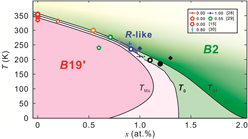Crossref Citations
This article has been cited by the following publications. This list is generated based on data provided by
Crossref.
Niitsu, Kodai
Kimura, Yuta
Omori, Toshihiro
and
Kainuma, Ryosuke
2018.
Cryogenic superelasticity with large elastocaloric effect.
NPG Asia Materials,
Vol. 10,
Issue. 1,
p.
e457.
Uskoković, Vuk
Tang, Sean
and
Wu, Victoria M.
2018.
On Grounds of the Memory Effect in Amorphous and Crystalline Apatite: Kinetics of Crystallization and Biological Response.
ACS Applied Materials & Interfaces,
Vol. 10,
Issue. 17,
p.
14491.
Aaltio, Ilkka
Fukuda, Takashi
and
Kakeshita, Tomoyki
2019.
A Perspective on Elastocaloric Effect in Ti–Ni-Based Shape Memory Alloys.
Shape Memory and Superelasticity,
Vol. 5,
Issue. 3,
p.
230.
Niitsu, Kodai
Xu, Sheng
Kimura, Yuta
Omori, Toshihiro
and
Kainuma, Ryosuke
2019.
Cryogenic Superelasticity and Concomitant Elastocaloric Effect.
Materia Japan,
Vol. 58,
Issue. 1,
p.
44.
Liang, Chuanxin
Wang, Dong
Wang, Zhao
Ding, Xiangdong
and
Wang, Yunzhi
2020.
Revealing the atomistic mechanisms of strain glass transition in ferroelastics.
Acta Materialia,
Vol. 194,
Issue. ,
p.
134.
Niitsu, K.
Date, H.
and
Kainuma, R.
2020.
Thermal activation of stress-induced martensitic transformation in Ni-rich Ti-Ni alloys.
Scripta Materialia,
Vol. 186,
Issue. ,
p.
263.
Guo, Wenqian
Feng, Bo
Yang, Ying
Ren, Yang
Liu, Yinong
Yang, Hong
Yang, Qin
Cui, Lishan
Tong, Xin
and
Hao, Shijie
2022.
Effect of laser scanning speed on the microstructure, phase transformation and mechanical property of NiTi alloys fabricated by LPBF.
Materials & Design,
Vol. 215,
Issue. ,
p.
110460.
Niitsu, Kodai
Yano, Yoshiki
Kainuma, Ryosuke
and
Inui, Haruyuki
2022.
Thermal Activation Theory of Isothermal Martensitic Transformations: Classical Interpretation of Nonergodicity in Transformation Strain.
SSRN Electronic Journal ,
Kimura, Yuta
Xu, Xiao
Han, Kwangsik
Niitsu, Kodai
Omori, Toshihiro
Umetsu, Rie Y.
and
Kainuma, Ryosuke
2023.
R-Phase Transformation in Ti<sub>50−</sub><i><sub>x</sub></i>Ni<sub>47+</sub><i><sub>x</sub></i>Fe<sub>3</sub> Shape Memory Alloys.
MATERIALS TRANSACTIONS,
Vol. 64,
Issue. 7,
p.
1591.
Niitsu, K.
Yano, Y.
Kainuma, R.
and
Inui, H.
2023.
Viscosity of superelasticity: A comprehensive interpretation of nonreciprocal isothermal dynamics, kinetic arrest, and nonergodic anelastic strain based on thermal activation of martensitic transformations.
Physical Review B,
Vol. 108,
Issue. 13,
Ryklina, Elena
Polyakova, Kristina
Komarov, Victor
Murygin, Semen
Konopatsky, Anton
Andreev, Vladimir
and
Ulanov, Adilet
2024.
On Transformation and Stress–Strain–Temperature Behavior of Fine-Grained Ni-Rich NiTi Wire vs. Aging Mode.
Metals,
Vol. 15,
Issue. 1,
p.
3.
Li, Qiuzhen
Chen, Yuxuan
Liu, Yinong
Jiang, Daqiang
Yang, Youyi
Yang, Hong
Yu, Kaiyuan
Ren, Yang
and
Cui, Lishan
2024.
Non-linear temperature dependences of pseudoelastic stress and stress hysteresis of a nanocrystalline Ni47Ti50Fe3 alloy.
Acta Materialia,
Vol. 265,
Issue. ,
p.
119625.
Chu, Hanchi
Zhao, Zhihao
Fang, Jiaye
Xiao, Yao
Lin, Jianping
and
Min, Junying
2025.
Ni nanosegregation reduces temperature dependence of stress-induced martensitic transformation in Ni50.9Ti49.1 shape memory alloy.
Journal of Materials Research and Technology,
Vol. 35,
Issue. ,
p.
4996.
Sato, Shunsuke
Tobe, Hirobumi
Sawada, Kenichiro
Tokoku, Chihiro
Nakagawa, Takao
Sato, Eiichi
Araki, Yoshikazu
Xu, Sheng
Xu, Xiao
Omori, Toshihiro
and
Kainuma, Ryosuke
2025.
Shape memory alloys for cryogenic actuators.
Communications Engineering,
Vol. 4,
Issue. 1,



